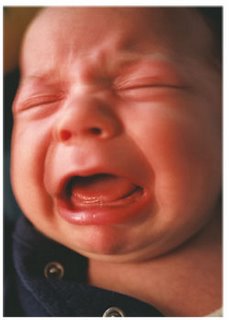Tuesday, January 23, 2007
Literature Review: Severe Sepsis in Children

Watson, R.S., Carcillo, J.A. (2005). Scope and epidemiology of pediatric sepsis. Pediatric Critical Care Medicine, 6 (supplement) S3-S5.
WHO defines "severe" sepsis as that which causes acidosis and/or hypotension (low blood pressure). There are four major killers of children worldwide:
- pneumonia
- diarrhoea
- malaria
- measles
(in order of deaths per year, highest to lowest.) People in developed countries don't think of diarrhoea as a deadly condition, but it kills children like you wouldn't believe. Check out what WHO has to say about it:
Amongst the poor and especially in developing countries, diarrhoea is a major killer. In 1998, diarrhoea was estimated to have killed 2.2 million people, most of whom were under 5 years of age (WHO, 2000). Each year there are approximately 4 billion cases of diarrhoea worldwide.
4 billion. Crazy, huh? If it were spread evenly throughout the year (unlikely), that'd be almost eleven million a day. Anyhoo, moving right along...
Low & Very Low Birth Weight (VLBW) infants made up one quarter of all paediatric sepsis cases in the US in 1995.
Sepsis in children often occurs with an underlying condition. In babies, it's usually chronic lung disease or congenital heart disease. In the 1-9 years bracket, neuromuscular disease is more common. In adolescents, cancer.
Severe sepsis is associated with a 10.3% hospital mortality in children. 7.8% in those who were previously healthy, and 12.8% in kids with underlying disease. Overall 4 400 deaths associated with severe sepsis. Endocarditis and infections of the CNS had the highest mortality. (All US figures from 1995.)
Sepsis is expensive. 1.7 billion total hospital cost associated with severe sepsis nationally.
A preliminary look at 1999 data shows a pattern of increased incidence and decreased mortality. The authors postulate increase in VLBW babies and increased rate of sepsis among those babies.
One of the difficulties of getting better at treating children who are vulnerable to infection because of underlying diseases is that they survive longer, which increases the 'at risk' population. That probably sounds horribly callous, but it's a reality of healthcare today: we've gotten better at keeping people alive, so we need to deal with patients who are more vulnerable to infections--in every age group, not just paediatrics. Everybody's got their 'frequent flyer' stories... patients who present again and again with pneumonia, bronchiolitis, vomiting and diarrhoea, name your poison.
1.6 million neonates die worldwide every year from infection. That's not solely premature babies, folks... that's any baby under 28 days old. Newborns, in other words.
They point out that sepsis can usually be identified in developing countries without sophisticated laboratory facilities. Tachycardia (a faster than usual heart rate) and other physical signs can be predictive of sepsis, and the use of cheap antibiotics in patients identified in this way has significantly reduced mortality rate.
Shock is the most important risk factor for mortality in septic children.
The authors warn about the difficulty of generalising results in adult studies to paediatric populations. This is not a new problem. It's often difficult to justify doing trials on kids. Getting ethics approval is fraught, and parents are obviously worried about the safety of their children so obtaining consent is no picnic either.
Trouble is, adults and babies are different (duh). What works for severe sepsis in adults may not be as effective in children, or have unforseen consequences particularly when you take the differences in their underlying diseases into account.
Posted by PaedsRN at 1:19 AM















i was wondering how I could be added to this site? my blog site is nicunursing.blogspot.com
-Neonatal Nurse
There is an axiom among ER nurses concerning sick kids:
"If an infant, toddler, or small child submits to noxious or painful procedures without protest, it is likely that the child is either chronically ill or very acutely ill and about to crump."
I have found that to be true in my experience. If a toddler is able to fight me while I'm doing something to them, I take that as an encouraging sign. It doesn't mean that the kid is okay, but at least the kid has some fight in them. Limp, lethargic kids scare the crap out of me.
Excellent post!
Thanks so much for this post. I work in rural Africa and see many cases of pediatric sepsis...the only diagnostic tools I have are my senses. It's a huge challenge and I'm always looking for more information and new ways to improve my practice.
Thank you for this post. I work in rural Africa and came across a lot of the very cases this post (and the linked article) mentions. I am always looking for more information and tips on best practice for the kind of setting I'm in. My only diagnostic tools are my 5 senses and medical supplies are often in poor supply. It's good to read about others' experiences. Take care.
Thanks for sharing it was very informative ,now do you mean diarrhea or diarrhoea?